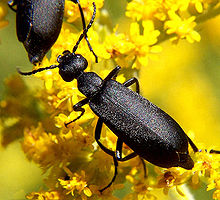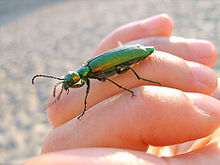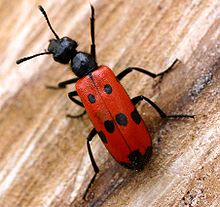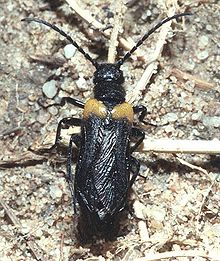- Blister beetle
-
Blister beetles Lytta aenea [1] Scientific classification Kingdom: Animalia Phylum: Arthropoda Class: Insecta Order: Coleoptera Suborder: Polyphaga Infraorder: Cucujiformia Superfamily: Tenebrionoidea Family: Meloidae
Gyllenhal, 1810Subfamilies Eleticinae
Meloinae
Nemognathinae
TetraonycinaeBlister beetles are beetles (Coleoptera) of the family Meloidae, so called for their defensive secretion of a blistering agent, cantharidin. There are approximately 7,500 known species worldwide. Many are conspicuous and some aposematically colored, announcing their toxicity to would-be predators.
Contents
Description
Cantharidin is a poisonous chemical that causes blistering of the skin. Cantharidin is used medically to remove warts[2] and is collected for this purpose from species of the genera Mylabris and Lytta, especially Lytta vesicatoria, better known as "Spanish fly".
Blister beetles are hypermetamorphic, going through several larval stages, the first of which is typically a mobile triungulin. The larvae are insectivorous, mainly attacking bees, though a few feed on grasshopper eggs; while sometimes considered parasitoids, it appears that in general, the meloid larva consumes the immature host along with its provisions, and can often survive on the provisions alone, thus they are not obligatory parasitoids but rather food parasites that are facultatively parasitoid, or simply predatory. The adults sometimes feed on flowers and leaves of plants of such diverse families like Amaranthaceae, Asteraceae, Fabaceae, and Solanaceae.
Toxicity
The blister beetle genus Epicauta is highly toxic to horses. A few beetles consumed in a single feeding of alfalfa hay may be lethal[3]. Poisonings have also been reported after use of "Spanish fly"-type folk medicines, and after handling blister beetle individuals. The toxic chemical is cantharidin.
Systematics
Subfamily Eleticinae
Tribe Derideini
- Anthicoxenus
- Deridea
- Iselma
- Iselmeletica
Tribe Morphozonitini
- Ceriselma
- Morphozonitis
- Steniselma
Tribe Eleticini
- Eletica
Tribe Spasticini
- Eospasta
- Protomeloe
- Spastica
- Xenospasta
Subfamily Meloinae
Tribe Cerocomini
- Anisarthrocera
- Cerocoma
- Diaphorocera
- Rhampholyssa
- Rhampholyssodes
Tribe Epicautini
- Denierella
- Epicauta
- Linsleya
- Psalydolytta
Tribe Eupomphini
- Cordylospasta
- Cysteodemus
- Eupompha
- Megetra
- Phodaga
- Pleropasta
- Tegrodera
 Meloe violaceus (Meloinae: Meloini). Note drop of dark orange defensive fluid on thorax.
Meloe violaceus (Meloinae: Meloini). Note drop of dark orange defensive fluid on thorax.
Tribe Lyttini
- Acrolytta
- Afrolytta
- Alosimus
- Berberomeloe
- Cabalia
- Dictyolytta
- Eolydus
- Epispasta
- Lagorina
- Lydomorphus
- Lydulus
- Lydus
- Lytta
- Lyttolydulus
- Lyttonyx
- Megalytta
- Muzimes
- Oenas
- Parameloe
- Paroenas
- Physomeloe
- Prionotolytta
- Prolytta
- Pseudosybaris
- Sybaris
- Teratolytta
- Tetraolytta
- Trichomeloe
Tribe Meloini
- Cyaneolytta
- Lyttomeloe
- Meloe
- Spastomeloe
- Spastonyx
Tribe Mylabrini
- Actenodia
- Ceroctis
- Croscherichia
- Hycleus
- Lydoceras
- Mimesthes
- Mylabris
- Paractenodia
- Pseudabris
- Semenovilia
- Xanthabris
Tribe Pyrotini
- Bokermannia
- Brasiliota
- Denierota
- Glaphyrolytta
- Lyttamorpha
- Picnoseus
- Pseudopyrota
- Pyrota
- Wagneronota
Genera incertae sedis
- Australytta
- Calydus
- Gynapteryx
- Oreomeloe
- Pseudomeloe
Subfamily Nemognathinae
Tribe Horiini
- Cissites
- Horia
- Synhoria
Tribe Nemognathini
- Cochliophorus
- Euzonitis
- Gnathium
- Gnathonemula
- Leptopalpus
- Megatrachelus
- Nemognatha
- Palaestra
- Palaestrida
- Pseudozonitis
- Rhyphonemognatha
- Stenodera
- Zonitis
- Zonitodema
- Zonitolytta
- Zonitomorpha
- Zonitoschema
Tribe Sitarini
- Allendeselazaria
- Apalus
- Ctenopus
- Glasunovia
- Nyadatus
- Sitaris
- Sitarobrachys
- Stenoria
Genera incertae sedis
- Hornia
- Onyctenus
- Sitaromorpha
- Tricrania
Subfamily Tetraonycinae
Tribe Tetraonycini
- Meloetyphlus
- Opiomeloe
- Tetraonyx
See also
References
- ^ Cirrus Digital Blister Beetle Lytta aenea
- ^ Bhattacharjee, Pradip; Brodell, Robert T. (2003). "Cantharidin". In Robert T. Brodell and Sandra Marchese Johnson, eds. Warts: Diagnosis and Management—an Evidence-Based Approach. London: Martin Dunitz. pp. 151–160. ISBN 1-84184-240-0. http://books.google.com/books?id=levLToql_NwC&pg=PA151&lpg=PA151&dq=Cantharidin+Bhattacharjee&source=bl&ots=p2w0aYD-nu&sig=SV2ndT-vmkj2cZDD-8anqoEpRsQ&hl=en&ei=9wpHStr5K-Wvtwe64JnCBg&sa=X&oi=book_result&ct=result&resnum=1.
- ^ University of Arizona VDL Blister Beetle Poisoning in Horses
External links
- Blister Beetle Intoxication: Cantharidin Poisoning
- meloidae.com
- blister beetles UF / IFAS Featured Creatures
- striped blister beetle, Epicauta vittata UF / IFAS Featured Creatures
* Beetle mania as 'extinct' insect found on Scots isle * Ever so Strange: Blister Beetles
Categories:- Tenebrionoidea
- Meloidae
Wikimedia Foundation. 2010.







